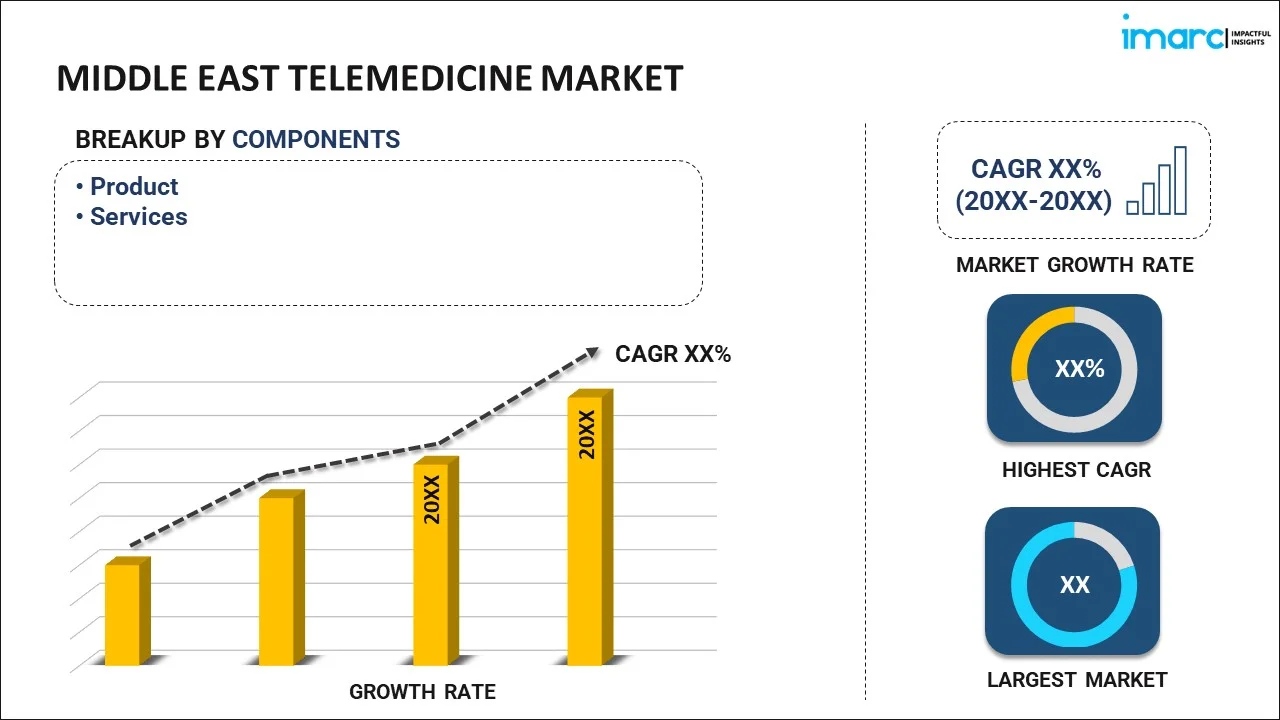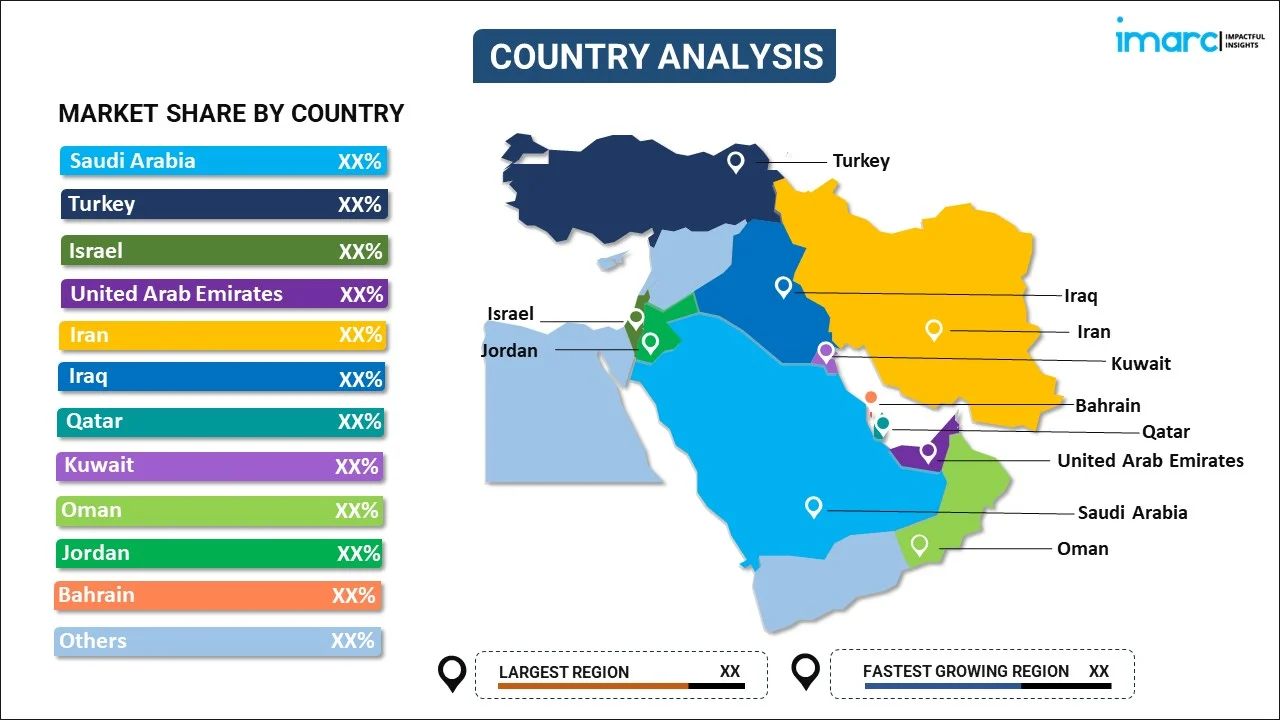
Middle East Telemedicine Market Report by Component (Product, Services), Modality (Real-Time, Store and Forward, and Others), Delivery Mode (Web/Mobile, Call Centers), Facility (Tele-Hospital, Tele-Home), Application (Teledermatology, Teleradiology, Telepsychiatry, Telepathology, Telecardiology, and Others), End User (Providers, Payers, Patients, and Others), and Country 2026-2034
Market Overview:
Middle East telemedicine market size reached USD 4,753.0 Million in 2025. Looking forward, IMARC Group expects the market to reach USD 18,804.8 Million by 2034, exhibiting a growth rate (CAGR) of 16.51% during 2026-2034. The growing occurrence of various chronic ailments, increasing relaxation of telemedicine regulations and the expansion of reimbursement policies for virtual care services, and rising prevalence of various infectious diseases caused by lethal viruses represent some of the key factors driving the market.
|
Report Attribute
|
Key Statistics
|
|---|---|
|
Base Year
|
2025
|
|
Forecast Years
|
2026-2034
|
|
Historical Years
|
2020-2025
|
| Market Size in 2025 | USD 4,753.0 Million |
| Market Forecast in 2034 | USD 18,804.8 Million |
| Market Growth Rate 2026-2034 | 16.51% |
Access the full market insights report Request Sample
Telemedicine offers a broad range of healthcare services delivered through various telecommunication technologies. It comprises synchronous telemedicine, which involves real-time communication between patients and healthcare providers, such as video conferencing or phone calls. It also consists of asynchronous telemedicine, which allows the exchange of non-real-time information, such as secure messaging and store-and-forward systems, wherein healthcare providers review patient data at a later time. It includes remote patient monitoring, which involves the use of devices to collect and transmit patient data to healthcare providers for continuous monitoring. It relies on robust technological infrastructure, including high-speed internet, secure communication platforms, and user-friendly interfaces. It also adheres to strict security protocols and regulations to ensure the confidentiality and privacy of patient information. Telemedicine must comply with local and international regulations, ensuring that practitioners meet licensing requirements and adhere to ethical standards. It contributes to better health outcomes, particularly in cases wherein early intervention is crucial. Telemedicine encourages active patient participation in their healthcare, fostering a sense of empowerment and engagement in the decision-making process.
Middle East Telemedicine Market Trends:
At present, the increasing prevalence of various chronic ailments, such as arthritis, obesity, diabetes, and cardiovascular complications, due to the adoption of unhealthy lifestyle habits represents one of the crucial factors impelling the growth of the market in the Middle East. Besides this, the rising integration of artificial intelligence (AI), machine learning (ML), and advanced data analytics is empowering healthcare providers to offer more personalized and effective telemedicine services in the region. The development of sophisticated telehealth platforms, wearable devices, and remote monitoring tools is also significantly enhancing the quality of virtual care. Furthermore, the increasing reliance on 5G technology is facilitating seamless and high-speed connectivity, overcoming previous limitations, and enabling real-time communication between healthcare professionals and patients. In addition, the growing prevalence of various infectious diseases caused by lethal viruses is offering a favorable market outlook in the region. Apart from this, the rising demand for convenience among patients is driving the adoption of telemedicine as it enables patients to schedule appointments from the comfort of their homes, eliminating the need for travel and reducing waiting times. The convenience factor also becomes particularly relevant for individuals with chronic conditions or those residing in remote areas, wherein access to healthcare facilities may be limited. Additionally, telemedicine presents an opportunity to streamline healthcare processes, reduce hospital admissions, and minimize overall healthcare expenditures. Remote patient monitoring and teleconsultations can prevent unnecessary hospital visits, enhancing the efficiency of healthcare delivery and promoting cost-effective solutions. Moreover, the increasing relaxation of telemedicine regulations and the expansion of reimbursement policies for virtual care services are bolstering the market growth in the region.
Middle East Telemedicine Market Segmentation:
IMARC Group provides an analysis of the key trends in each segment of the market, along with forecasts at the regional and country levels for 2026-2034. Our report has categorized the market based on component, modality, delivery mode, facility, application, and end user.
Component Insights:

To get detailed segment analysis of this market Request Sample
- Product
- Hardware
- Software
- Others
- Services
- Tele-Consulting
- Tele-Monitoring
- Tele-Education
The report has provided a detailed breakup and analysis of the market based on the component. This includes product (hardware, software, and others) and services (tele-consulting, tele-monitoring, and tele-education).
Modality Insights:
- Real-Time
- Store and Forward
- Others
A detailed breakup and analysis of the market based on the modality have also been provided in the report. This includes real-time, store and forward, and others.
Delivery Mode Insights:
- Web/Mobile
- Audio/Text-based
- Visualized
- Call Centers
The report has provided a detailed breakup and analysis of the market based on the delivery mode. This includes web/mobile (audio/text-based and visualized) and call centers.
Facility Insights:
- Tele-Hospital
- Tele-Home
A detailed breakup and analysis of the market based on the facility have also been provided in the report. This includes tele-hospital and tele-home.
Application Insights:
- Teledermatology
- Teleradiology
- Telepsychiatry
- Telepathology
- Telecardiology
- Others
The report has provided a detailed breakup and analysis of the market based on application. This includes teledermatology, teleradiology, telepsychiatry, telepathology, telecardiology, and others.
End User Insights:
- Providers
- Payers
- Patients
- Others
A detailed breakup and analysis of the market based on the end user have also been provided in the report. This includes providers, payers, patients, and others.
Country Insights:

To get detailed regional analysis of this market Request Sample
- Saudi Arabia
- Turkey
- Israel
- United Arab Emirates
- Iran
- Iraq
- Qatar
- Kuwait
- Oman
- Jordan
- Bahrain
- Others
The report has also provided a comprehensive analysis of all the major regional markets, which include Saudi Arabia, Turkey, Israel, United Arab Emirates, Iran, Iraq, Qatar, Kuwait, Oman, Jordan, Bahrain, and Others.
Competitive Landscape:
The market research report has also provided a comprehensive analysis of the competitive landscape. Competitive analysis such as market structure, key player positioning, top winning strategies, competitive dashboard, and company evaluation quadrant has been covered in the report. Also, detailed profiles of all major companies have been provided.
Middle East Telemedicine Market Report Coverage:
| Report Features | Details |
|---|---|
| Base Year of the Analysis | 2025 |
| Historical Period | 2020-2025 |
| Forecast Period | 2026-2034 |
| Units | Million USD |
| Scope of the Report | Exploration of Historical and Forecast Trends, Industry Catalysts and Challenges, Segment-Wise Historical and Predictive Market Assessment:
|
| Components Covered |
|
| Modalities Covered | Real-Time, Store and Forward, Others |
| Delivery Modes Covered |
|
| Facilities Covered | Tele-Hospital, Tele-Home |
| Applications Covered | Teledermatology, Teleradiology, Telepsychiatry, Telepathology, Telecardiology, Others |
| End Users Covered | Providers, Payers, Patients, Others |
| Countries Covered | Saudi Arabia, Turkey, Israel, United Arab Emirates, Iran, Iraq, Qatar, Kuwait, Oman, Jordan, Bahrain, Others |
| Customization Scope | 10% Free Customization |
| Post-Sale Analyst Support | 10-12 Weeks |
| Delivery Format | PDF and Excel through Email (We can also provide the editable version of the report in PPT/Word format on special request) |
Key Questions Answered in This Report:
- How has the Middle East telemedicine market performed so far and how will it perform in the coming years?
- What has been the impact of COVID-19 on the Middle East telemedicine market?
- What is the breakup of the Middle East telemedicine market on the basis of component?
- What is the breakup of the Middle East telemedicine market on the basis of modality?
- What is the breakup of the Middle East telemedicine market on the basis of delivery mode?
- What is the breakup of the Middle East telemedicine market on the basis of facility?
- What is the breakup of the Middle East telemedicine market on the basis of application?
- What is the breakup of the Middle East telemedicine market on the basis of end user?
- What are the various stages in the value chain of the Middle East telemedicine market?
- What are the key driving factors and challenges in Middle East telemedicine?
- What is the structure of the Middle East telemedicine market and who are the key players?
- What is the degree of competition in the Middle East telemedicine market?
Key Benefits for Stakeholders:
- IMARC’s industry report offers a comprehensive quantitative analysis of various market segments, historical and current market trends, market forecasts, and dynamics of the Middle East telemedicine market from 2020-2034.
- The research report provides the latest information on the market drivers, challenges, and opportunities in the Middle East telemedicine market.
- Porter's five forces analysis assist stakeholders in assessing the impact of new entrants, competitive rivalry, supplier power, buyer power, and the threat of substitution. It helps stakeholders to analyze the level of competition within the Middle East telemedicine industry and its attractiveness.
- Competitive landscape allows stakeholders to understand their competitive environment and provides an insight into the current positions of key players in the market.
Need more help?
- Speak to our experienced analysts for insights on the current market scenarios.
- Include additional segments and countries to customize the report as per your requirement.
- Gain an unparalleled competitive advantage in your domain by understanding how to utilize the report and positively impacting your operations and revenue.
- For further assistance, please connect with our analysts.
 Request Customization
Request Customization
 Speak to an Analyst
Speak to an Analyst
 Request Brochure
Request Brochure
 Inquire Before Buying
Inquire Before Buying




.webp)




.webp)












